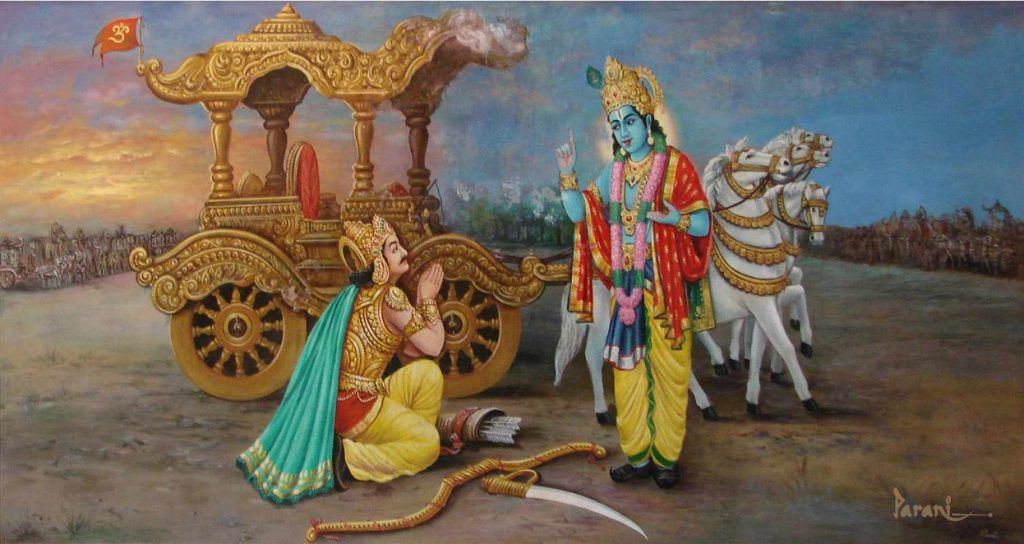The Bhagavad Gita | Chapter 2 : The Practice of Yoga |
अथ द्वितीयोஉध्यायः ।
सञ्जय उवाच ।
तं तथा कृपयाविष्टमश्रुपूर्णाकुलेक्षणम् ।
विषीदन्तमिदं वाक्यमुवाच मधुसूदनः ॥
श्रीभगवानुवाच ।
कुतस्त्वा कश्मलमिदं विषमे समुपस्थितम् ।
अनार्यजुष्टमस्वर्ग्यमकीर्तिकरमर्जुन ॥
क्लैब्यं मा स्म गमः पार्थ नैतत्त्वय्युपपद्यते ।
क्षुद्रं हृदयदौर्बल्यं त्यक्त्वोत्तिष्ठ परन्तप ॥
अर्जुन उवाच ।
कथं भीष्ममहं साङ्ख्ये द्रोणं च मधुसूदन ।
इषुभिः प्रतियोत्स्यामि पूजार्हावरिसूदन ॥
...............
.......................
या निशा सर्वभूतानां तस्यां जागर्ति संयमी ।
यस्यां जाग्रति भूतानि सा निशा पश्यतो मुनेः ॥
आपूर्यमाणमचलप्रतिष्ठं समुद्रमापः प्रविशन्ति यद्वत् ।
तद्वत्कामा यं प्रविशन्ति सर्वे स शान्तिमाप्नोति न कामकामी ॥
विहाय कामान्यः सर्वान्पुमांश्चरति निःस्पृहः ।
निर्ममो निरहङ्कारः स शान्तिमधिगच्छति ॥
एषा ब्राह्मी स्थितिः पार्थ नैनां प्राप्य विमुह्यति ।
स्थित्वास्यामन्तकालेஉपि ब्रह्मनिर्वाणमृच्छति ॥
ॐ तत्सदिति श्रीमद्भगवद्गीतासूपनिषत्सु ब्रह्मविद्यायां योगशास्त्रे श्रीकृष्णार्जुनसंवादे
साङ्ख्ययोगो नाम द्वितीयोஉध्यायः
Summary
Krishna responds to Arjuna by arguing that such timidity at this moment is "unworthy of a noble mind." Still, Arjuna insists that he cannot bear the thought of killing his kinsmen. In verses 11–17
अशोच्यानन्वशोचस्त्वं प्रज्ञावादांश्च भाषसे ।
गतासूनगतासूंश्च नानुशोचन्ति पण्डिताः ॥ 11 ॥
न त्वेवाहं जातु नासं न त्वं नेमे जनाधिपाः ।
न चैव न भविष्यामः सर्वे वयमतः परम् ॥ 12 ॥
देहिनोஉस्मिन्यथा देहे कौमारं यौवनं जरा ।
तथा देहान्तरप्राप्तिर्धीरस्तत्र न मुह्यति ॥ 13 ॥
मात्रास्पर्शास्तु कौन्तेय शीतोष्णसुखदुःखदाः ।
आगमापायिनोஉनित्यास्तांस्तितिक्षस्व भारत ॥ 14 ॥
यं हि न व्यथयन्त्येते पुरुषं पुरुषर्षभ ।
समदुःखसुखं धीरं सोஉमृतत्वाय कल्पते ॥ 15 ॥
नासतो विद्यते भावो नाभावो विद्यते सतः ।
उभयोरपि दृष्टोஉन्तस्त्वनयोस्तत्त्वदर्शिभिः ॥ 16 ॥
अविनाशि तु तद्विद्धि येन सर्वमिदं ततम् ।
विनाशमव्ययस्यास्य न कश्चित्कर्तुमर्हति ॥ 17 ॥
Krishna explains that Arjuna's "sorrow is sheer delusion" because physical sensations are transitory—just as life and death are transitory. Everything that exists has always existed. Arjuna and his family will simply pass from one body to the next in each life. Krishna urges Arjuna to do his duty in this life because his "Self" is eternal and part of the eternal fabric of the universe. Thus, Arjuna cannot really kill or be killed because it is only the body that can die.
In verse 31
Analysis
There is much conversation, starting in this chapter and continuing throughout the Gita, about the concept of the Self. Krishna's discussion often distinguishes the Self from the "I-sense," or ego. The self is the pure and elevated essence of a being, referred to in Sanskrit as the atman. It is unaffected by the physical world or by birth and death. Krishna provides the image of the Self shucking and changing bodies like clothing. Much of Krishna's advice to Arjuna involves letting go of ego and becoming wise through the understanding of the true Self.
Krishna lectures Arjuna on two types of yogic philosophy over the course of these verses. The first type is knowledge based, and the second is action based. What the translator refers to as "philosophy" in verse 39 is called Sankhya or jnana, Sanskrit words meaning "knowledge."
The point of karma yoga, as Krishna explains, is to perform action without attachment to the outcome of that action. In other words, karma yoga is the philosophy of doing right action and duty as opposed to selfish action. In doing right action, individuals do not accrue more karma but instead free themselves from the karmic consequences of their action. Through the practice of karma yoga, or selfless action, a person may move closer to samadhi, or a liberated mind.
In the context of daily life and relationships, the teachings from the Bhagavad Gita, particularly Chapter 2, offer valuable insights. Applying these principles can enhance our approach to love and relationships:
1. **Detachment and Understanding:** Just as Krishna advises Arjuna to detach from the physical aspects and recognize the eternal nature of the Self, in relationships, it's essential to understand that external circumstances and appearances are transitory. True love goes beyond physical or material aspects, focusing on the deeper connection between individuals.
2. **Selfless Action in Relationships:** The concept of karma yoga emphasizes performing actions without attachment to outcomes. Applying this in relationships means acting selflessly, prioritizing the well-being of your partner and the relationship itself over personal desires or expectations. This can create a harmonious and fulfilling connection.
3. **Wisdom and Self-Control:** Krishna encourages self-control and discipline to achieve a state where desires flow without causing suffering. In relationships, practicing self-discipline helps maintain composure during challenging times, fostering a space for open communication and understanding.
4. **Balancing Duty and Personal Growth:** Arjuna's duty as a warrior is highlighted, and similarly, individuals in relationships have responsibilities. Balancing these duties while also focusing on personal growth is crucial. Supporting your partner's growth and pursuing shared goals can strengthen the relationship.
5. **Letting Go of Ego:** Distinguishing the true Self from the ego is a recurring theme. In relationships, letting go of ego-driven behaviors and embracing humility and understanding can pave the way for a healthier and more compassionate connection.
6. **Mindful Communication:** Krishna advises Arjuna to clear his mind of confusion and desire. In relationships, practicing mindful communication involves expressing thoughts and feelings sincerely, without being attached to a specific outcome. This fosters understanding and reduces conflicts.
7. **Shared Spiritual Growth:** Just as Krishna introduces different types of yogic philosophy, couples can explore spiritual or personal growth together. This shared journey can deepen the bond and provide a common ground for understanding each other's perspectives.
Remember, the application of these teachings should align with individual beliefs and the dynamics of the specific relationship. By incorporating these principles into daily life, one can cultivate a more meaningful and spiritually aligned approach to love and relationships.
कृष्णम् वन्दे जगद्गुरुम🙏




Comments
Post a Comment